Being a teen means confronting change wherever you look. Both your body and your brain are developing rapidly, all while you’re expected to meet certain milestones at school and in your social groups. During such a volatile life stage, sleep should be a restful oasis. But how do you find the best mattress for a teenager when their needs are in flux?
The best beds for teens take their dynamic natures into account. They’re adaptable, sturdy, and outfitted with enough bonus features to charm tech-savvy adolescents. We’ve listed our top mattresses for teenage sleepers here, along with further shopping tips that should help parents decide on the right bed for their growing kids.
What’s the Best Mattress for Teenagers?
The DreamCloud is an exceptional bed for teenagers. Its hybrid design combines no less than four types of foam in its upper layers with a supportive innerspring unit at its base. It provides enough support (and, therefore, spinal alignment) for growing teens across most sleeping positions, and it’s affordably priced for its caliber.
Best Mattresses for Teens
- DreamCloud – Editor’s Pick
- Nectar – Best Memory Foam Mattress for Teens
- Helix Midnight – Best Mattress for Teenage Side Sleepers
- Bear Original – Best Mattress for Athletic Teens
- Saatva Classic – Best Mattress for Teenage Back Sleepers
- Brooklyn Bedding Brooklyn Essential – Best Hybrid Mattress for Teens
- Nolah Evolution – Best Luxury Mattress for Teens
- Titan Plus – Best Mattress for Plus-Size Teens
- Plank Firm – Best Firm Mattress for Teens
- Birch Natural – Best Organic Mattress for Teens
Compare The Best Beds for Teenagers
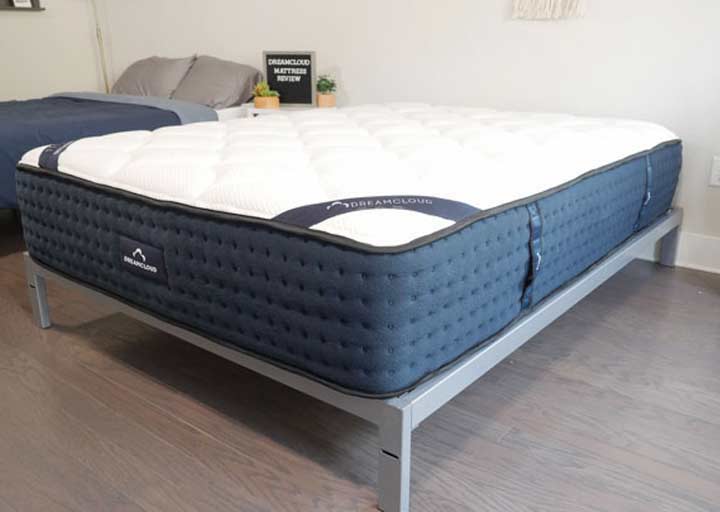
|
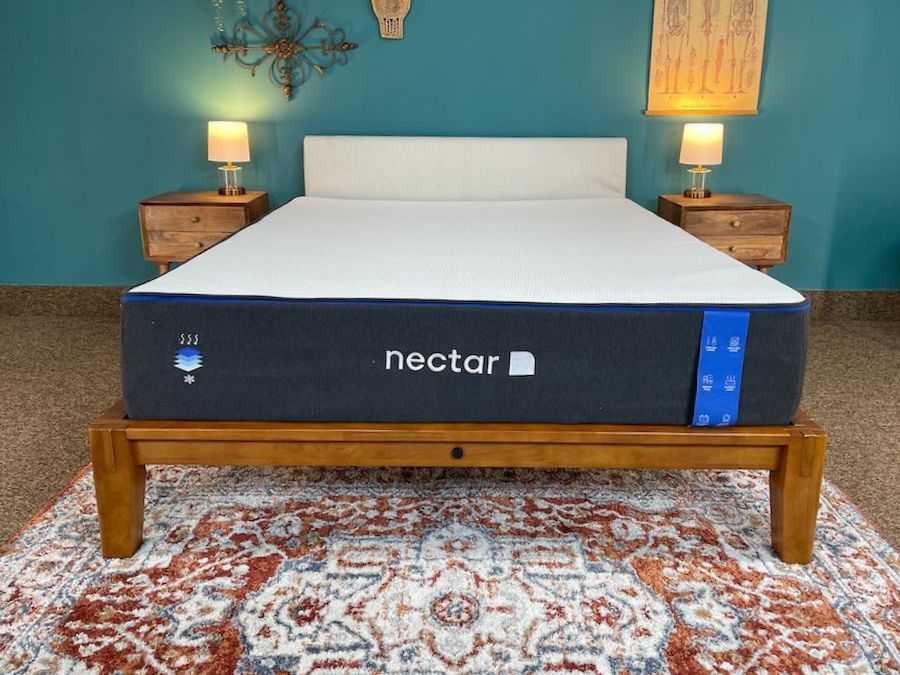
|
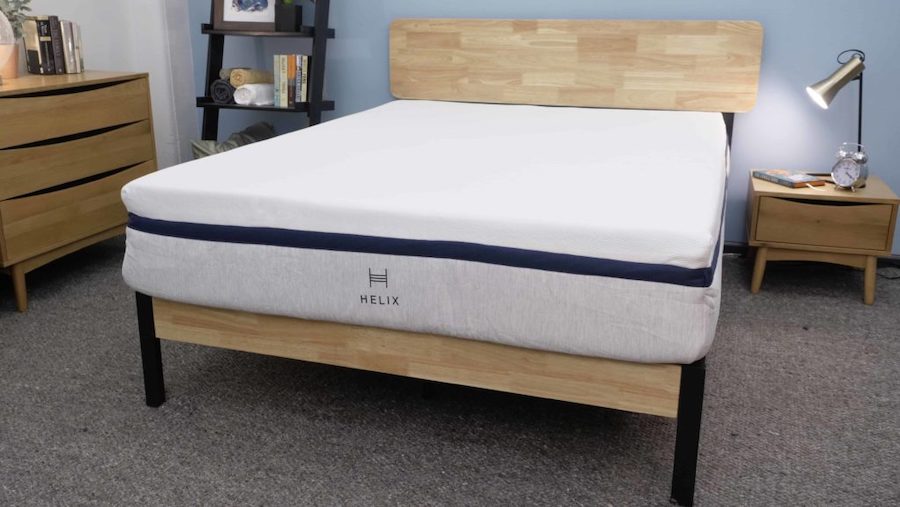
|
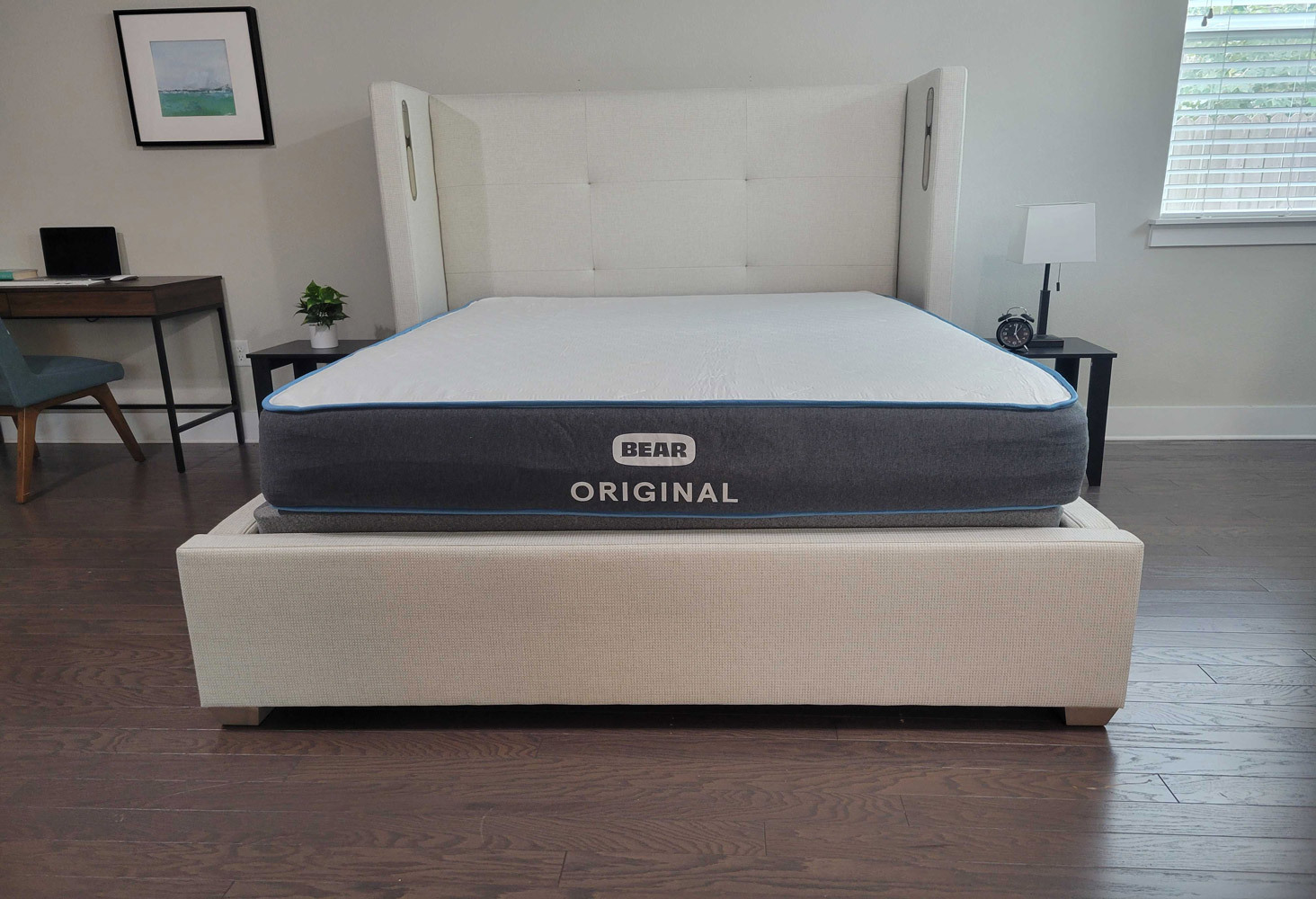
|
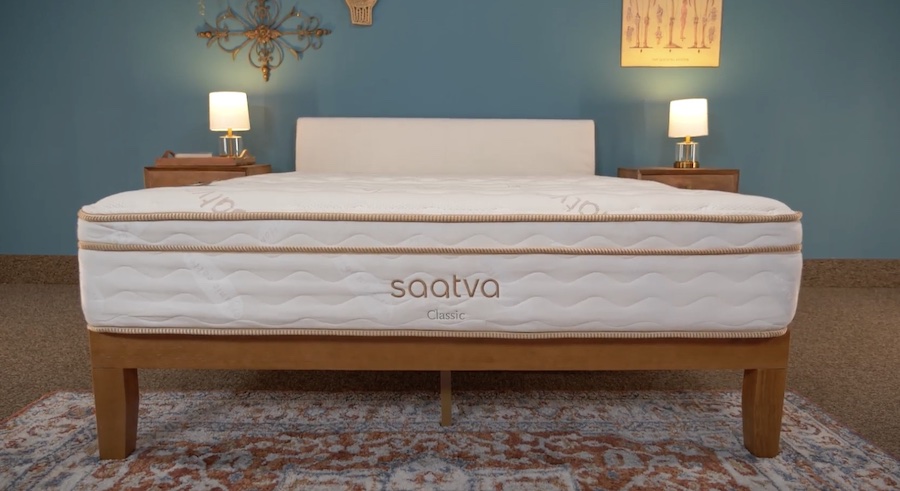
|

|
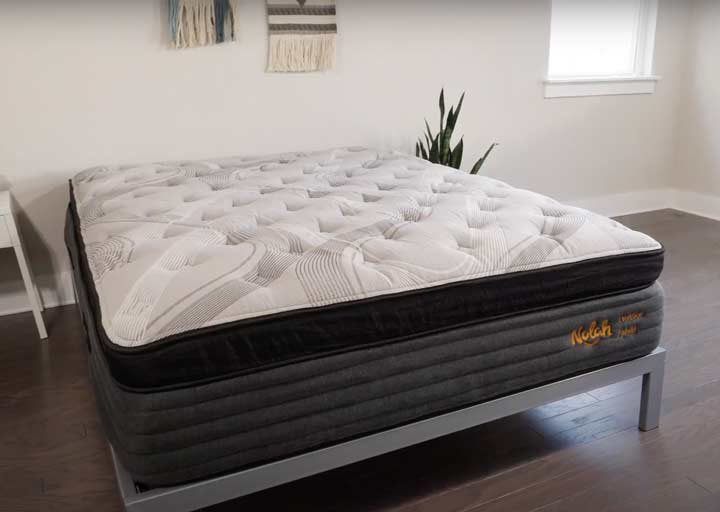
|
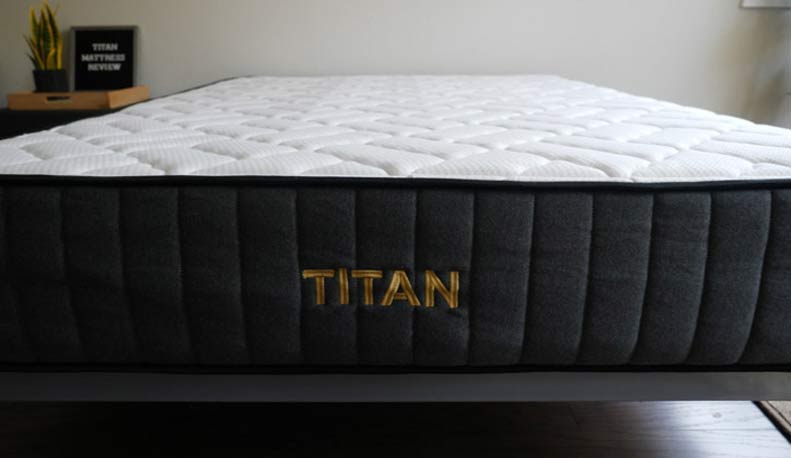
|
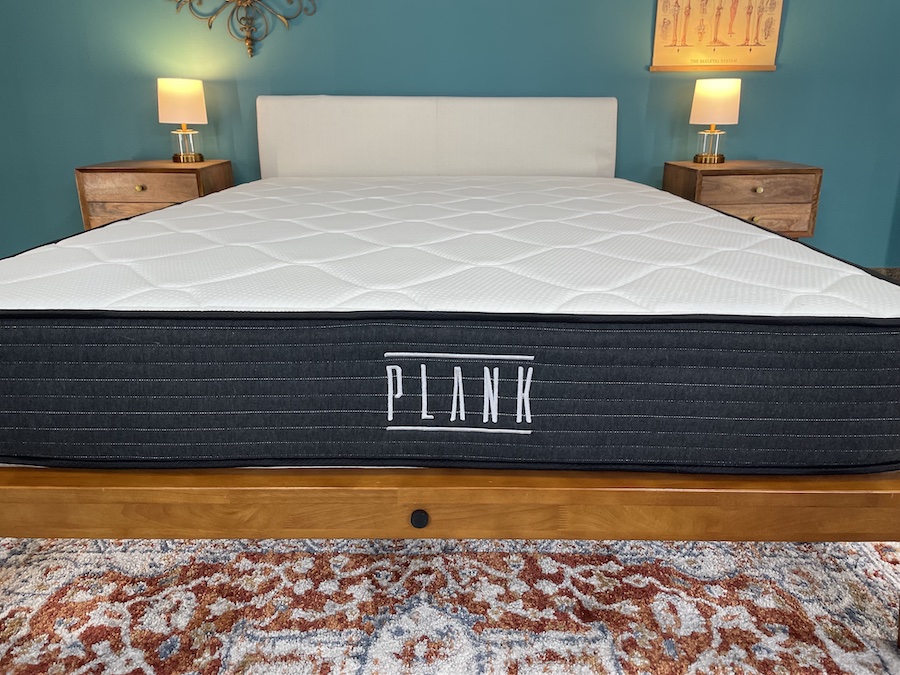
|
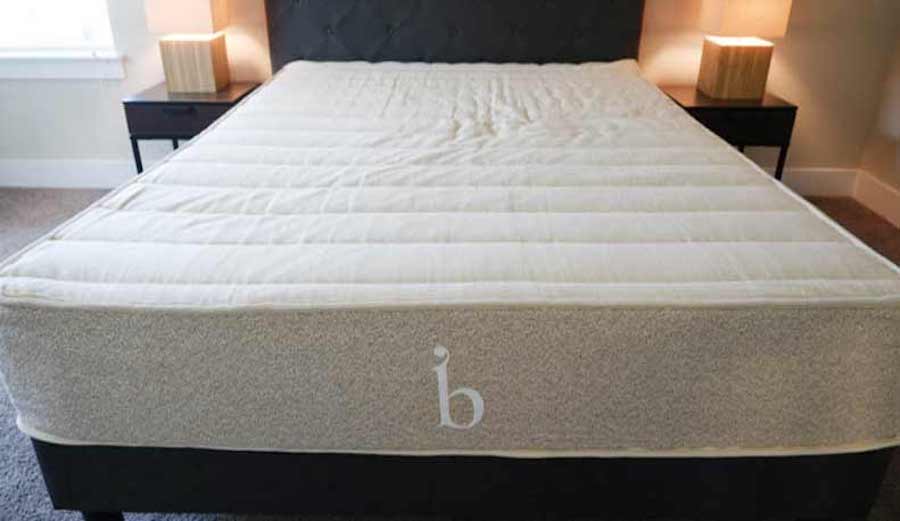
|
|
| DreamCloud Original Mattress | Nectar Mattress | Helix Midnight Mattress | Bear Original Mattress | Saatva Mattress | Brooklyn Bedding Essential | Nolah Evolution Hybrid Mattress | Titan Plus | Brooklyn Bedding Plank Firm Mattress | Birch Natural Mattress | |
| Rating | ||||||||||
| Firmness | Medium-firm: 6.5/10 | Medium-firm: 6.5/10 | Medium-firm: 6/10 | Medium-firm: 6.5/10 | Multiple firmness options | Multiple firmness options | Firm: 7.5/10 | Multiple firmness options | Medium-firm: 6.5/10 | |
| Material | Hybrid | Foam | Hybrid | Foam | Innerspring | Hybrid | Hybrid | Hybrid | Foam | Hybrid |
| Cooling |
|
— | — |
|
|
|
— | — | — |
|
| Warranty | Lifetime warranty | Lifetime warranty | 10-year warranty | Lifetime warranty | Lifetime warranty | 10-year warranty | Lifetime warranty | 10-year warranty | 10-year warranty | 25-year warranty |
| Shipping | Free shipping | Free shipping | Free shipping | Free shipping | Free white glove delivery | Free shipping | Free shipping | Free shipping | Free shipping | Free shipping |
| Trial Period | 365 nights | 365 nights | 100 nights | 120 nights | 365 nights | 120 nights | 120 nights | 120 nights | 120 nights | 100 nights |
| Best For | Back Sleepers, Hot Sleepers, Seniors | Back Sleepers, Side Sleepers, Hip Pain, Joint Pain | Couples, Back Sleepers, Side Sleepers | Hot Sleepers, Back Sleepers, Side Sleepers | Back Sleepers, Stomach Sleepers, Back Pain, Hot Sleepers | Back Sleepers, Side Sleepers, Hot Sleepers | Side Sleepers, Back Sleepers | Back Sleepers, Stomach Sleepers, Back Pain | Stomach Sleepers, Back Pain | Back Sleepers, Stomach Sleepers, Hot Sleepers |
Sleep Advisor’s Testing Methodology
At Sleep Advisor, our mattress reviews are based on findings from in-person tests that give us a genuine understanding of how the mattress feels and performs. For this roundup, we focused on the best mattresses for teenagers. We considered several factors when devising our list, paying particular attention to important features for teenagers.
During the teen years, sleepers may be prone to overheating and sweating1 at night. Therefore, mattresses with temperature-regulating elements can be of interest to teenagers. Further, considering teens can experience growth spurts2, good overall support for healthy spine alignment is also an important quality.
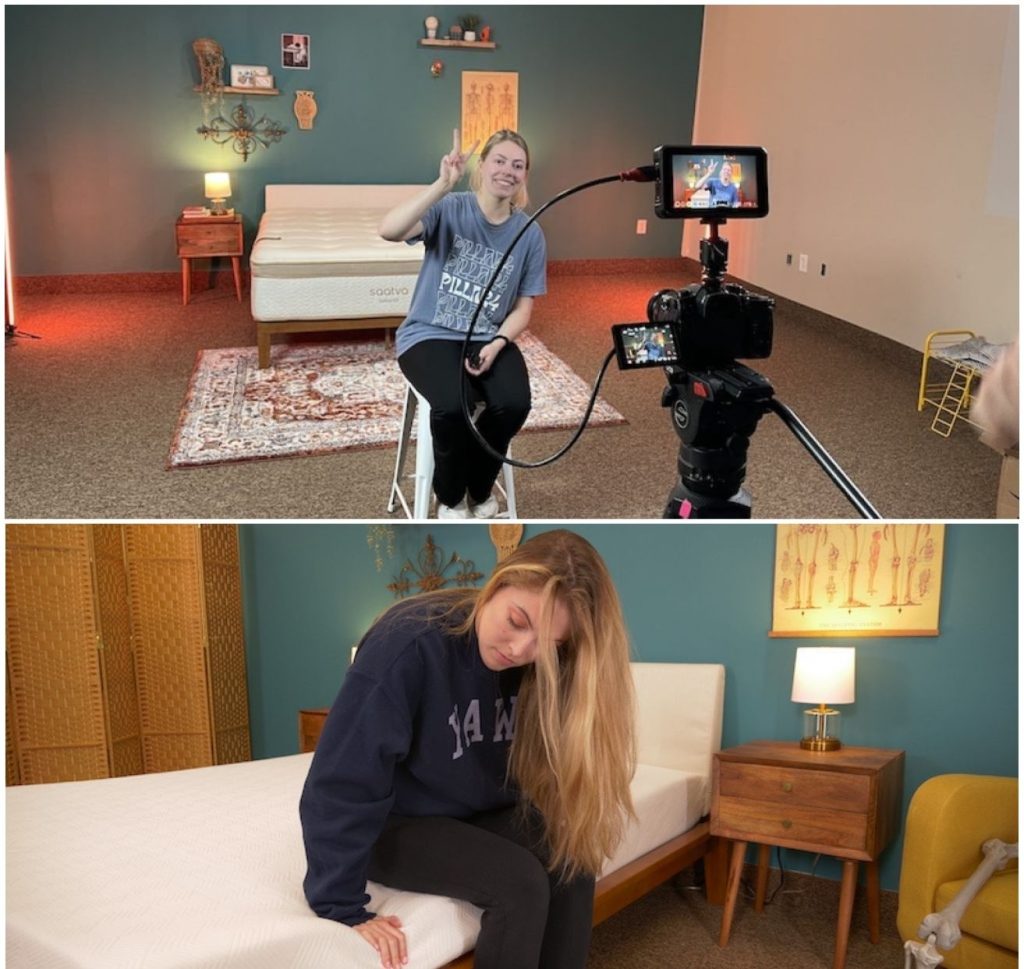
Top 10 Beds for Teenagers
DreamCloud – Editor’s Pick
DreamCloud Original Mattress
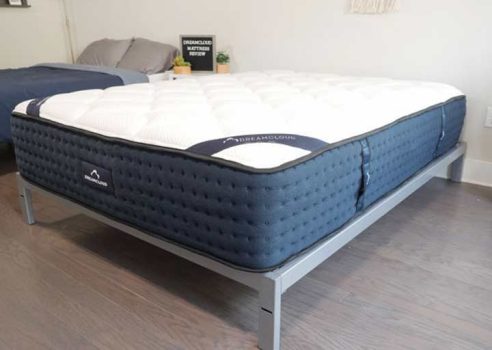
Luxurious hybrid at a great price with a lifetime warranty.
Material
Hybrid
Trial Period
365 nights
Shipping Method
Free shipping
Firmness
Medium-firm: 6.5/10
Warranty
Lifetime warranty
Price Range
$$$$$
We recommend this mattress for the following sleeper types:
Hot Sleepers
If you often overheat while you sleep, this mattress should help you stay cool.Seniors
This bed is perfect for senior sleepers.Back Sleeping
Ideal for average weight back sleepers.Financing Options
Financing options are available for this mattress.
DreamCloud Original Mattress

Luxurious hybrid at a great price with a lifetime warranty.
Material
Hybrid
Warranty
Lifetime warranty
Firmness
Medium-firm: 6.5/10
Shipping Method
Free shipping
Trial Period
365 nights
Price Range
$$$$$
We recommend this mattress for the following sleeper types:
Hot Sleepers
If you often overheat while you sleep, this mattress should help you stay cool.Seniors
This bed is perfect for senior sleepers.Back Sleeping
Ideal for average weight back sleepers.Financing Options
Financing options are available for this mattress.

DreamCloud Original Mattress
Luxurious hybrid at a great price with a lifetime warranty.
Material
Hybrid
Firmness
Medium-firm: 6.5/10
Trial Period
365 nights
Warranty
Lifetime warranty
Shipping Method
Free shipping
Price Range
$$$$$
We recommend this mattress for the following sleeper types:
Hot Sleepers
If you often overheat while you sleep, this mattress should help you stay cool.Seniors
This bed is perfect for senior sleepers.Back Sleeping
Ideal for average weight back sleepers.Financing Options
Financing options are available for this mattress.
Why the DreamCloud Earned Best Mattress for Teens Overall
DreamCloud fits a lofty 8-layer mattress into convenient packaging for delivery, which is impressive enough. But when you factor in the budget-friendly price of this bed, as well as all the elements of its hybrid construction, you’ll see why it handily won the title of the best mattress for teenagers.
“It feels like luxury at an affordable cost,” said Stuart, one of several testers who evaluated the DreamCloud. He and I were both taken with the bed’s cashmere blend cover, surprisingly firmer feel, and the support we got from the springs—especially on our backs and stomachs.
As a stomach sleeper myself, I adore this mattress, and make no secret of the fact that it’s one of my favorites. Most teenagers should appreciate the high degree of support it offers as well as how swanky it looks.
Our Take: “DreamCloud feels really well-made and luxurious … It’s a budget mattress that doesn’t feel budget.” – Stuart Petty, Sleep Advisor Mattress Tester
Customer Reviews of the DreamCloud
The DreamCloud Original scores a solid 4.7 out of 5 stars among customers on its site. While some customers appreciate the value and affordability of the DreamCloud Original mattress, others find it to be on the heavier side, which could make moving or rotating the mattress more challenging.
Want to get to know this bed better? Read our complete DreamCloud mattress review or check out our best mattresses for 2024.
Nectar – Best Memory Foam Mattress for Teens
Nectar Mattress
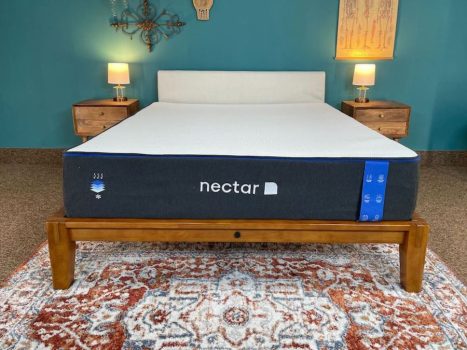
Nectar offers the deeper hug of a traditional memory foam bed but with updated cooling and a Forever warranty.
Material
Foam
Trial Period
365 nights
Shipping Method
Free shipping
Firmness
Medium-firm: 6.5/10
Warranty
Lifetime warranty
Price Range
$$$$$
We recommend this mattress for the following sleeper types:
Joint Pain
This bed is perfect for anyone suffering from joint pain.Hip Pain
This bed is perfect for anyone suffering from hip pain.Back Sleeping
Ideal for lightweight and average weight back sleepers.Side Sleeping
Ideal for lightweight and average weight side sleepers.Financing Options
Financing options are available for this mattress.
Nectar Mattress

Nectar offers the deeper hug of a traditional memory foam bed but with updated cooling and a Forever warranty.
Material
Foam
Warranty
Lifetime warranty
Firmness
Medium-firm: 6.5/10
Shipping Method
Free shipping
Trial Period
365 nights
Price Range
$$$$$
We recommend this mattress for the following sleeper types:
Joint Pain
This bed is perfect for anyone suffering from joint pain.Hip Pain
This bed is perfect for anyone suffering from hip pain.Back Sleeping
Ideal for lightweight and average weight back sleepers.Side Sleeping
Ideal for lightweight and average weight side sleepers.Financing Options
Financing options are available for this mattress.

Nectar Mattress
Nectar offers the deeper hug of a traditional memory foam bed but with updated cooling and a Forever warranty.
Material
Foam
Firmness
Medium-firm: 6.5/10
Trial Period
365 nights
Warranty
Lifetime warranty
Shipping Method
Free shipping
Price Range
$$$$$
We recommend this mattress for the following sleeper types:
Joint Pain
This bed is perfect for anyone suffering from joint pain.Hip Pain
This bed is perfect for anyone suffering from hip pain.Back Sleeping
Ideal for lightweight and average weight back sleepers.Side Sleeping
Ideal for lightweight and average weight side sleepers.Financing Options
Financing options are available for this mattress.
Why the Nectar Earned Best Memory Foam Mattress for Teens
The Nectar mattress is an all-foam bed with that coveted slow-sinking feel, coupled with a mid-range firmness that should fit most sleepers. I think it’s a great fit for teens due to its balanced profile. It has a lot of initial pressure relief at the top, but a strong, supportive base at the bottom, so it’s not as flimsy or prone to sagging as other foam beds.
It’s also an eminently affordable mattress, with queens costing just a bit more than $1,000 (before any discounts, which run frequently).
My Take: I don’t hesitate to recommend the Nectar to folks who want a budget-friendly foam bed. Its medium-firm profile and underlying support are impressive—just don’t get your hopes up too high if you’re a stomach sleeper like me.
Customer Reviews of the Nectar
With thousands of reviews on Nectar’s website, the Nectar mattress has an average 4.8 out of 5 stars. One common customer complaint about the Nectar mattress is its longer-than-average break-in period, while many customers praise its excellent value and comfort once fully settled.
Want to learn more about this bed? Visit our full Nectar mattress review, or consult our list of the best memory foam mattresses.
Helix Midnight – Best Mattress for Teenage Side Sleepers
Helix Midnight Mattress
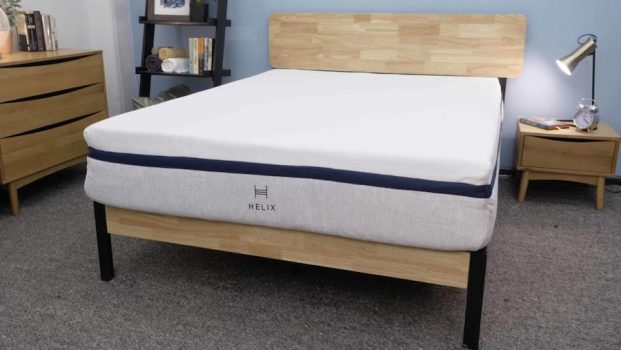
Part of Helix’s core line of mattresses, the Midnight has a hybrid construction that’s particularly suited to back and side sleepers.
Material
Hybrid
Trial Period
100 nights
Shipping Method
Free shipping
Firmness
Medium-firm: 6/10
Warranty
10-year warranty
Price Range
$$$$$
We recommend this mattress for the following sleeper types:
Couples
This bed has great motion isolation so you will not feel your partner tossing and turning at night.Back Sleeping
Ideal for lightweight and average weight back sleepers.Side Sleeping
Ideal for lightweight and average weight side sleepers.Financing Options
Financing options are available for this mattress.
Helix Midnight Mattress

Part of Helix’s core line of mattresses, the Midnight has a hybrid construction that’s particularly suited to back and side sleepers.
Material
Hybrid
Warranty
10-year warranty
Firmness
Medium-firm: 6/10
Shipping Method
Free shipping
Trial Period
100 nights
Price Range
$$$$$
We recommend this mattress for the following sleeper types:
Couples
This bed has great motion isolation so you will not feel your partner tossing and turning at night.Back Sleeping
Ideal for lightweight and average weight back sleepers.Side Sleeping
Ideal for lightweight and average weight side sleepers.Financing Options
Financing options are available for this mattress.

Helix Midnight Mattress
Part of Helix’s core line of mattresses, the Midnight has a hybrid construction that’s particularly suited to back and side sleepers.
Material
Hybrid
Firmness
Medium-firm: 6/10
Trial Period
100 nights
Warranty
10-year warranty
Shipping Method
Free shipping
Price Range
$$$$$
We recommend this mattress for the following sleeper types:
Couples
This bed has great motion isolation so you will not feel your partner tossing and turning at night.Back Sleeping
Ideal for lightweight and average weight back sleepers.Side Sleeping
Ideal for lightweight and average weight side sleepers.Financing Options
Financing options are available for this mattress.
Why the Helix Midnight Earned Best Mattress for Teenage Side Sleepers
If your teen sleeps on their side, they’re in the majority; most people do. But it’s still important to find a bed that meets their needs, and side sleepers do best with plush comfort layers to ease pressure on the hips and shoulders.
The Helix Midnight’s medium-firm feel and use of memory foam are highly beneficial for side sleepers. Memory foam does an excellent job of cradling the sleeper’s body so that pressure melts away for a comfortable night’s sleep, while just the right amount of firmness keeps you amply supported.
Our Take: “I like how my hips and shoulders have a little cushion around them.” – Emma Mattei, Sleep Advisor Mattress Tester
Customer Reviews of the Helix Midnight
The Helix Midnight rates 4.5 stars out of 5 on Helix’s website. The main negative is that reviewers tend to find it too soft for their liking and feel as though they’re sinking. But overall, users say they’re getting a great nights’ sleep and some pain relief.
Looking for more info? Check out our Helix Midnight mattress review or check out our best mattresses for side sleepers picks.
Bear Original – Best Mattress for Athletic Teens
Bear Original Mattress
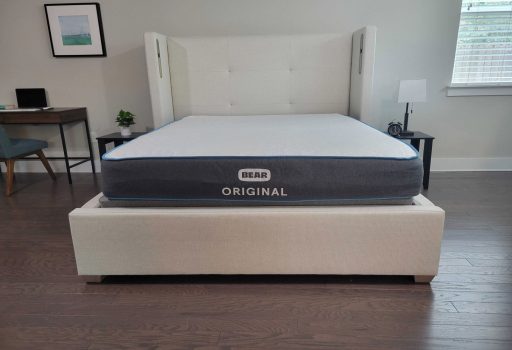
This flagship model was thoughtfully crafted and assembled to be an attractive all-foam option for athletes who need better rest.
Material
Foam
Trial Period
120 nights
Shipping Method
Free shipping
Firmness
Medium-firm: 6.5/10
Warranty
Lifetime warranty
Price Range
$$$$$
We recommend this mattress for the following sleeper types:
Hot Sleepers
If you often overheat while you sleep, this mattress should help you stay cool.Back Sleeping
Ideal for lightweight and average weight back sleepers.Side Sleeping
Ideal for lightweight and average weight side sleepers.Financing Options
Financing options are available for this mattress.
Bear Original Mattress

This flagship model was thoughtfully crafted and assembled to be an attractive all-foam option for athletes who need better rest.
Material
Foam
Warranty
Lifetime warranty
Firmness
Medium-firm: 6.5/10
Shipping Method
Free shipping
Trial Period
120 nights
Price Range
$$$$$
We recommend this mattress for the following sleeper types:
Hot Sleepers
If you often overheat while you sleep, this mattress should help you stay cool.Back Sleeping
Ideal for lightweight and average weight back sleepers.Side Sleeping
Ideal for lightweight and average weight side sleepers.Financing Options
Financing options are available for this mattress.

Bear Original Mattress
This flagship model was thoughtfully crafted and assembled to be an attractive all-foam option for athletes who need better rest.
Material
Foam
Firmness
Medium-firm: 6.5/10
Trial Period
120 nights
Warranty
Lifetime warranty
Shipping Method
Free shipping
Price Range
$$$$$
We recommend this mattress for the following sleeper types:
Hot Sleepers
If you often overheat while you sleep, this mattress should help you stay cool.Back Sleeping
Ideal for lightweight and average weight back sleepers.Side Sleeping
Ideal for lightweight and average weight side sleepers.Financing Options
Financing options are available for this mattress.
Why the Bear Original Earned Best Mattress for Athletic Teens
Athletic teens often struggle with pain, muscle inflammation, and pressure in the shoulders and legs. These complaints can keep them up at night, regardless of how tired they are after their activities. The Bear Original should help: it has multiple cooling materials and a responsive layer that adapts to the sleeper’s body to encourage a speedy recovery.
Our Take: “It’s a little firmer than the typical all-foam mattress, which should make it a little bit more versatile for different kinds of sleepers.” – Stuart, Sleep Advisor Mattress Tester
Customer Reviews of the Bear Original
According to Bear’s website, the Bear Original scores about 4.5 out of 5 stars. Customers appreciate the Bear Original mattress for its excellent pressure relief but have reported that its edge support may be lacking, which could affect those who use the full mattress surface.
Want to learn more? Read our full review of the Bear Original mattress, or browse the best mattresses for athletes.
Saatva Classic – Best Mattress for Teenage Back Sleepers
Saatva Mattress
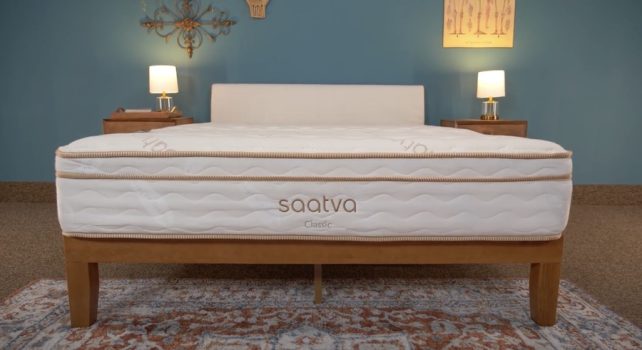
Coil-on-coil structure gives this elevated innerspring bed a luxurious feel and versatility.
Material
Innerspring
Trial Period
365 nights
Shipping Method
Free white glove delivery
Firmness
Multiple firmness options
Warranty
Lifetime warranty
Price Range
$$$$$
We recommend this mattress for the following sleeper types:
Hot Sleepers
If you often overheat while you sleep, this mattress should help you stay cool.Back Pain
This bed is perfect for anyone suffering from back pain.Back Sleeping
Ideal for lightweight, average weight, and heavyweight back sleepers.Stomach Sleeping
Ideal for lightweight and average weight stomach sleepers.Financing Options
Financing options are available for this mattress.
Saatva Mattress

Coil-on-coil structure gives this elevated innerspring bed a luxurious feel and versatility.
Material
Innerspring
Warranty
Lifetime warranty
Firmness
Multiple firmness options
Shipping Method
Free white glove delivery
Trial Period
365 nights
Price Range
$$$$$
We recommend this mattress for the following sleeper types:
Hot Sleepers
If you often overheat while you sleep, this mattress should help you stay cool.Back Pain
This bed is perfect for anyone suffering from back pain.Back Sleeping
Ideal for lightweight, average weight, and heavyweight back sleepers.Stomach Sleeping
Ideal for lightweight and average weight stomach sleepers.Financing Options
Financing options are available for this mattress.

Saatva Mattress
Coil-on-coil structure gives this elevated innerspring bed a luxurious feel and versatility.
Material
Innerspring
Firmness
Multiple firmness options
Trial Period
365 nights
Warranty
Lifetime warranty
Shipping Method
Free white glove delivery
Price Range
$$$$$
We recommend this mattress for the following sleeper types:
Hot Sleepers
If you often overheat while you sleep, this mattress should help you stay cool.Back Pain
This bed is perfect for anyone suffering from back pain.Back Sleeping
Ideal for lightweight, average weight, and heavyweight back sleepers.Stomach Sleeping
Ideal for lightweight and average weight stomach sleepers.Financing Options
Financing options are available for this mattress.
Why the Saatva Classic Earned Best Mattress for Teenage Back Sleepers
The Saatva Classic’s unique design should offer the right amount of robust support for teens who sleep on their backs. Its memory foam “crown” is designed to provide extra lift to the lower back region and alleviate tension, and its Euro top even has firmer quilting around the lumbar area. Meanwhile, the zoned coils in its first innerspring unit give this same region an added boost.
This bed is also highly customizable, so you can find the perfect fit for your teen based on their needs.
My Take: Support’s the name of the game here, because under the Euro pillow top is not one, but two coil layers to keep you feeling lifted. As a bonus, this dual-coil model lends extra structure and long-term durability to the bed.
Customer Reviews of the Saatva Classic
The Saatva Classic rates 4.8 stars out of 5 on Saatva’s website. One negative aspect customers found with the Saatva Classic mattress is that it may feel too firm for some users, while a notable advantage is its high-quality materials, providing durability and support.
Looking to learn more? Read our full Saatva Classic review or peruse the best mattresses for back sleepers.
Brooklyn Bedding Brooklyn Essential – Best Hybrid Mattress for Teens
Brooklyn Bedding Essential

The Brooklyn Essential is an impressively affordable hybrid with a simple yet satisfying construction.
Material
Hybrid
Trial Period
120 nights
Shipping Method
Free shipping
Firmness
Medium-firm: 6.5/10
Warranty
10-year warranty
Price Range
$$$$$
We recommend this mattress for the following sleeper types:
Hot Sleepers
If you often overheat while you sleep, this mattress should help you stay cool.Back Sleeping
Ideal for lightweight and average weight back sleepers.Side Sleeping
Ideal for lightweight and average weight side sleepers.Financing Options
Financing options are available for this mattress.
Brooklyn Bedding Essential

The Brooklyn Essential is an impressively affordable hybrid with a simple yet satisfying construction.
Material
Hybrid
Warranty
10-year warranty
Firmness
Medium-firm: 6.5/10
Shipping Method
Free shipping
Trial Period
120 nights
Price Range
$$$$$
We recommend this mattress for the following sleeper types:
Hot Sleepers
If you often overheat while you sleep, this mattress should help you stay cool.Back Sleeping
Ideal for lightweight and average weight back sleepers.Side Sleeping
Ideal for lightweight and average weight side sleepers.Financing Options
Financing options are available for this mattress.

Brooklyn Bedding Essential
The Brooklyn Essential is an impressively affordable hybrid with a simple yet satisfying construction.
Material
Hybrid
Firmness
Medium-firm: 6.5/10
Trial Period
120 nights
Warranty
10-year warranty
Shipping Method
Free shipping
Price Range
$$$$$
We recommend this mattress for the following sleeper types:
Hot Sleepers
If you often overheat while you sleep, this mattress should help you stay cool.Back Sleeping
Ideal for lightweight and average weight back sleepers.Side Sleeping
Ideal for lightweight and average weight side sleepers.Financing Options
Financing options are available for this mattress.
Why the Brooklyn Bedding Brooklyn Essential Earned Best Hybrid Mattress for Teens
If your teen is looking for a bouncy but comfortable bed, a hybrid may be the best choice. Hybrid mattresses have foam and coils, offering the benefits of comfort foams and the extra support and cooling of springs. They tend to feel a bit less plush than all-foam options.
The Brooklyn Bedding Brooklyn Essential has both a quality hybrid design and budget-friendly price point, making it an appealing option for someone who may grow out of it in the future.
Our Take: Essential is a great word to describe this bed. You get everything you need in a hybrid at a fairly affordable price, without sacrificing any of the comfort or quality.
Customer Reviews of the Brooklyn Essential
According to Brooklyn Bedding’s website, the Essential mattress scores about 4.5 out of 5 stars. Users have noted that the Brooklyn Bedding Essential mattress offers a budget-friendly option for customers, however some have mentioned that it may not be as durable as higher-priced alternatives.
Want more info? Our Brooklyn Essential review is coming soon. In the meantime, check out our best hybrid mattress picks.
Nolah Evolution – Best Luxury Mattress for Teens
Nolah Evolution Hybrid Mattress
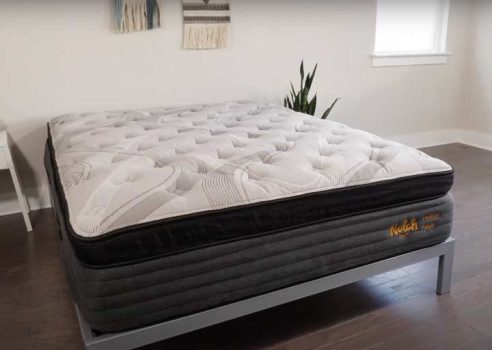
Nolah’s innovative pressure-relieving abilities should be an excellent fit for side-sleepers, and if you struggle with overheating, the AirFoamICE™ technology should keep you cool all night long.
Material
Hybrid
Trial Period
120 nights
Shipping Method
Free shipping
Firmness
Multiple firmness options
Warranty
Lifetime warranty
Price Range
$$$$$
Nolah Evolution Hybrid Mattress

Nolah’s innovative pressure-relieving abilities should be an excellent fit for side-sleepers, and if you struggle with overheating, the AirFoamICE™ technology should keep you cool all night long.
Material
Hybrid
Warranty
Lifetime warranty
Firmness
Multiple firmness options
Shipping Method
Free shipping
Trial Period
120 nights
Price Range
$$$$$

Nolah Evolution Hybrid Mattress
Nolah’s innovative pressure-relieving abilities should be an excellent fit for side-sleepers, and if you struggle with overheating, the AirFoamICE™ technology should keep you cool all night long.
Material
Hybrid
Firmness
Multiple firmness options
Trial Period
120 nights
Warranty
Lifetime warranty
Shipping Method
Free shipping
Price Range
$$$$$
Why the Nolah Evolution Earned Best Luxury Mattress for Teens
The Nolah Evolution is a tall mattress with an above-average number of layers, making it an impressive addition to any teen’s bedroom. As a hybrid, it combines the advantages of pressure-relieving foams and springs, but it also adds some proprietary extras to the mix. Nolah’s famous AirFoam™, for example, allegedly cools and cushions far better than most traditional memory foams.
The Evolution is also available in three firmness levels. This customizability should appeal to pickier teenagers who want just the right feel from their bed.
Our Take: “I could even feel the zoned support in the springs working to support my body weight appropriately.” – Stuart, Sleep Advisor Mattress Tester
Customer Reviews of the Nolah Evolution
Earning a 4.9 out of 5 stars on Nolah’s website, the Nolah Evolution seems to be a hit. Customers appreciate the Nolah Evolution mattress for its superior pressure relief, but some have mentioned that the edge support could be improved for a more consistent sleep surface.
Curious about this bed? Peruse our Nolah Evolution mattress review or check out the best luxury mattresses.
Titan Plus – Best Mattress for Plus-Size Teens
Titan Plus
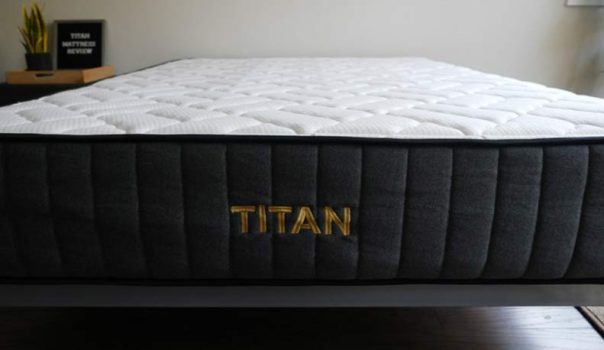
This specially-designed hybrid is made for heavier sleepers to help them get better, more comfortable sleep.
Material
Hybrid
Trial Period
120 nights
Shipping Method
Free shipping
Firmness
Firm: 7.5/10
Warranty
10-year warranty
Price Range
$$$$$
We recommend this mattress for the following sleeper types:
Back Pain
This bed is perfect for anyone suffering from back pain.Back Sleeping
Ideal for heavyweight back sleepers.Stomach Sleeping
Ideal for heavyweight stomach sleepers.Financing Options
Financing options are available for this mattress.
Titan Plus

This specially-designed hybrid is made for heavier sleepers to help them get better, more comfortable sleep.
Material
Hybrid
Warranty
10-year warranty
Firmness
Firm: 7.5/10
Shipping Method
Free shipping
Trial Period
120 nights
Price Range
$$$$$
We recommend this mattress for the following sleeper types:
Back Pain
This bed is perfect for anyone suffering from back pain.Back Sleeping
Ideal for heavyweight back sleepers.Stomach Sleeping
Ideal for heavyweight stomach sleepers.Financing Options
Financing options are available for this mattress.

Titan Plus
This specially-designed hybrid is made for heavier sleepers to help them get better, more comfortable sleep.
Material
Hybrid
Firmness
Firm: 7.5/10
Trial Period
120 nights
Warranty
10-year warranty
Shipping Method
Free shipping
Price Range
$$$$$
We recommend this mattress for the following sleeper types:
Back Pain
This bed is perfect for anyone suffering from back pain.Back Sleeping
Ideal for heavyweight back sleepers.Stomach Sleeping
Ideal for heavyweight stomach sleepers.Financing Options
Financing options are available for this mattress.
Why the Titan Plus Earned Best Mattress for Plus-Size Teens
The Titan Plus was built to be stronger than typical bed-in-a-box mattresses. With a weight capacity of up to 1,000 pounds and a robust innerspring unit, it’s exceedingly durable, and should stay comfortable for larger bodies after years of use.
I’ve watched multiple plus-size folks test this bed at our studio, and they tend to be very pleased with it. A plus-size teenager should have the same experience: they should feel supported, pleasantly buoyed, and cushioned simultaneously.
Our Take: “Bottom line: for all plus-size sleepers, there should be plenty of support and pressure relief regardless of your sleeping position.” – Spencer, Sleep Advisor Mattress Tester
Customer Reviews of the Titan Plus
Users on Titan by Brooklyn Bedding’s site have given the Titan Plus a 4.7 out of 5 stars. Customers find the Titan Plus mattress to offer exceptional durability and support, but some mention that it might be too firm for those who prefer a softer feel.
Looking to learn more? Explore our full Titan Plus mattress review or our list of the best mattresses for heavy people.
Plank Firm – Best Firm Mattress for Teens
Brooklyn Bedding Plank Firm Mattress
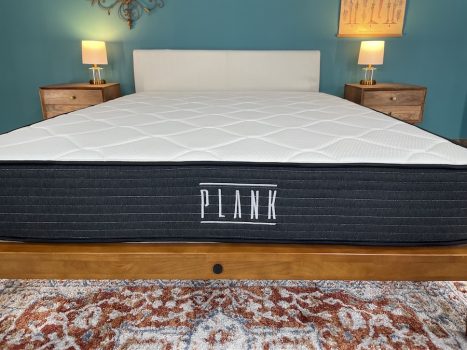
Those in the market for a Firm bed now have a dual-sided choice to see what they require to sleep well-supported and comfortable in Plank Firm, a new product from Brooklyn Bedding.
Material
Foam
Trial Period
120 nights
Shipping Method
Free shipping
Firmness
Multiple firmness options
Warranty
10-year warranty
Price Range
$$$$$
Brooklyn Bedding Plank Firm Mattress

Those in the market for a Firm bed now have a dual-sided choice to see what they require to sleep well-supported and comfortable in Plank Firm, a new product from Brooklyn Bedding.
Material
Foam
Warranty
10-year warranty
Firmness
Multiple firmness options
Shipping Method
Free shipping
Trial Period
120 nights
Price Range
$$$$$

Brooklyn Bedding Plank Firm Mattress
Those in the market for a Firm bed now have a dual-sided choice to see what they require to sleep well-supported and comfortable in Plank Firm, a new product from Brooklyn Bedding.
Material
Foam
Firmness
Multiple firmness options
Trial Period
120 nights
Warranty
10-year warranty
Shipping Method
Free shipping
Price Range
$$$$$
Why the Plank Firm Earned Best Firm Mattress for Teens
Teenagers often contend with restlessness and may need a bed that keeps them from getting stuck in the mattress as they toss and turn. The Plank Firm has a distinctive claim to fame: it labels itself the firmest mattress on the market, with two firmness levels to choose from in its flippable design.
My Take: It doesn’t get more solid than the Plank. This is one of the firmest mattresses on the online market.
Customer Reviews of the Plank Firm
On Plank’s website, the Plank Firm gets 4.8 out of 5 stars. Customers appreciate the Brooklyn Bedding Plank Firm mattress for its exceptional firmness, but some have found it to be too rigid for their comfort preferences.
Interested in this bed? Consult our in-depth Plank Firm mattress review or check out our best firm mattress options.
Birch Natural – Best Organic Mattress for Teens
Birch Natural Mattress
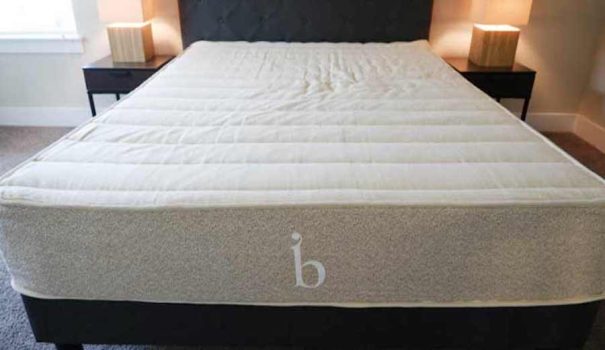
An eco-friendly bed that pairs latex and individually wrapped coils for a versatile hybrid sleep experience.
Material
Hybrid
Trial Period
100 nights
Shipping Method
Free shipping
Firmness
Medium-firm: 6.5/10
Warranty
25-year warranty
Price Range
$$$$$
We recommend this mattress for the following sleeper types:
Hot Sleepers
If you often overheat while you sleep, this mattress should help you stay cool.Back Sleeping
Ideal for average weight back sleepers.Stomach Sleeping
Ideal for average weight stomach sleepers.Financing Options
Financing options are available for this mattress.
Birch Natural Mattress

An eco-friendly bed that pairs latex and individually wrapped coils for a versatile hybrid sleep experience.
Material
Hybrid
Warranty
25-year warranty
Firmness
Medium-firm: 6.5/10
Shipping Method
Free shipping
Trial Period
100 nights
Price Range
$$$$$
We recommend this mattress for the following sleeper types:
Hot Sleepers
If you often overheat while you sleep, this mattress should help you stay cool.Back Sleeping
Ideal for average weight back sleepers.Stomach Sleeping
Ideal for average weight stomach sleepers.Financing Options
Financing options are available for this mattress.

Birch Natural Mattress
An eco-friendly bed that pairs latex and individually wrapped coils for a versatile hybrid sleep experience.
Material
Hybrid
Firmness
Medium-firm: 6.5/10
Trial Period
100 nights
Warranty
25-year warranty
Shipping Method
Free shipping
Price Range
$$$$$
We recommend this mattress for the following sleeper types:
Hot Sleepers
If you often overheat while you sleep, this mattress should help you stay cool.Back Sleeping
Ideal for average weight back sleepers.Stomach Sleeping
Ideal for average weight stomach sleepers.Financing Options
Financing options are available for this mattress.
Why the Birch Natural Earned Best Organic Mattress for Teens
The Birch Natural’s natural and organic components are meticulously sourced, making it a desirable addition to any eco-friendly household with growing teens. The bed boasts a variety of certifications—including eco-INSTITUT certified latex and Global Organic Textile Standard (GOTS) certified organic cotton and wool— that prove it’s been made with the planet and your health in mind.
Its Talalay latex and pocketed coils also lend the bed a springiness that younger sleepers may find appealing.
Our Take: “The Birch Natural mattress should make a great bed for eco-conscious sleepers who want lots of bounce and a medium feel.” – Stuart, Sleep Advisor Mattress Tester
Customer Reviews of the Birch Natural
According to Birch’s website, the Birch Natural scores a 4.6 out of 5 stars. While some users consider the Birch Natural mattress to be on the pricier side, it gains customer appreciation for its organic materials and sustainable, eco-friendly construction.
Want to know more? Consult our full Birch mattress review or check out our best organic mattresses for more options.
Teens and Sleep: Common Challenges
There are aspects of healthy development during adolescence that need to be considered when shopping for a mattress for a teenager to help ensure teens get good sleep.
Rapidly Growing Body
The initial adolescent growth spurt3 typically occurs between the ages of 9-10 for boys and 10-11 for girls, and according to reports, many teens are experiencing the first stages of puberty earlier than before4.
This is an opportune time to find a good bed to accommodate a growing body. However, growing pains, which are typical, may keep some children and teens up at night. Foam and latex mattresses for teens can be especially useful at easing aches and pains, so if your teen is experiencing aches as they grow, you might consider these types of beds.
Read Our Full Guide: Best Mattress for Athletes
Their Circadian Rhythm Changes
The circadian rhythm keeps our bodies in sync with the world around us by helping us wake up when the sun is up and makes us get tired when it gets dark. Teens experience a change in the circadian rhythm5 when they enter puberty, which is known as sleep phase delay, and it takes some time to adjust. This is most often why you’ll find them getting up later than normal and not feeling tired in the evenings.
This is a natural development that occurs throughout the adolescent years. While new bedding might not bring that rhythm into a consistent cycle, it can certainly help to ensure that whatever sleep they get, even if it’s very little, will be very restful and of good overall quality.
Sleep Needs Change
Teens aged 13 to 18 need eight to 10 hours of sleep6 a night, but if the bed is uncomfortable, this could make them more apt to stay up late.. A good mattress for teenagers will not only support their body and ensure that any sleep they get is deep, but it may also encourage them to go to bed a bit earlier.
If your kid is an athlete or simply active, you might want to consider a product with Celliant fiber material to give him or her that extra boost and chance to recover before the next day comes (and we recommend you research this material).
Learn more: How Much Sleep Do Teens Really Need?
What to Consider When Buying a Mattress for a Teenager
Bed Size
Teenagers can experience significant growth spurts.2 This means they likely need an upgrade from their childhood mattress.
Their height will be an important consideration when choosing the bed size. Twin and Full beds are typically about 5 inches shorter than Twin XL, Queen, and King beds. If you have the budget and space, you may want to consider a Queen, as this will allow your teen to stretch out more and may keep you from another upgrade. However, a Twin XL may be a great choice if you’re short on room or money as your teenager gets taller.
This handy chart shows just how different Twin and Queen sizes are:
| Size | Inches |
| Twin Mattress | 39” x 75” |
| Twin XL Mattress | 39” x 75” |
| Full Mattress | 54” x 75” |
| Queen Mattress | 60” x 80” |
| King Mattress | 76” x 80” |
Need more details? Check out our complete Mattress Size Chart.
What Type of Bed is Best for Teenagers?
Memory Foam
Memory foam supports the body well; it’s usually good for side sleepers, and you can find both affordable and expensive ones. These beds also provide great middle-of-the-road comfort (not too hard, not too soft), making them ideal for sharing. This is a good option if your teen plans to take this bed with them further through life.
It’s important to remember that only the top couple of inches are typically memory foam, and below that, it’s generic foam. Keep an eye out for densities, as something that is not as dense may fall short on quality.
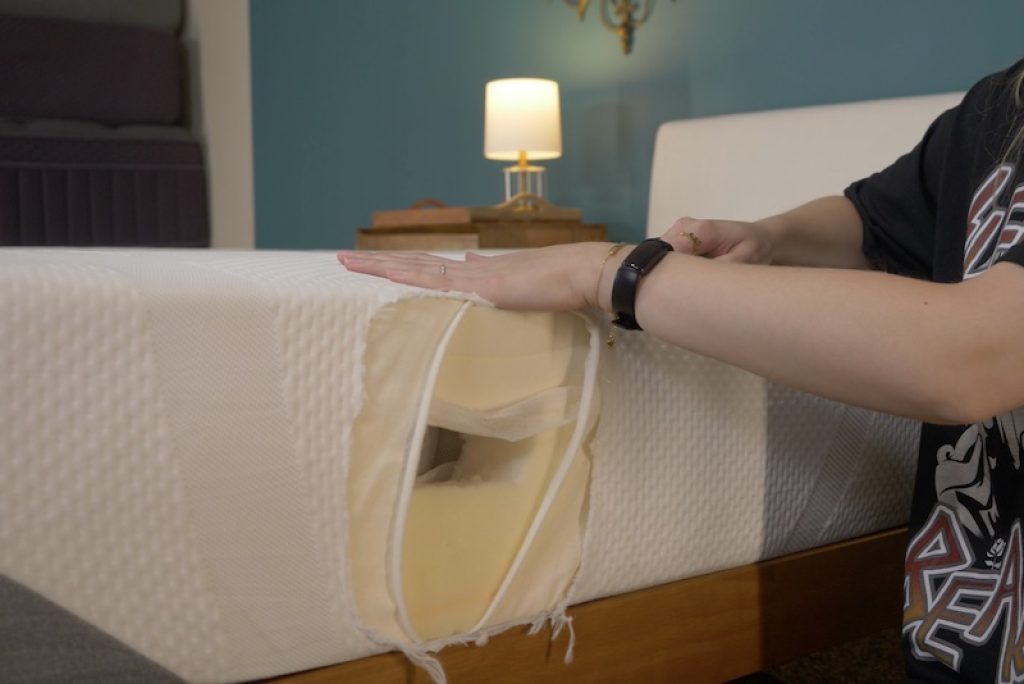
Find Out More: Best Memory Foam Mattress
Latex
Latex tends to have hypoallergenic properties7, but it’s always a good idea to check individual product descriptions. Latex is also highly durable and eco-friendly. While latex beds provide the gentle support of a memory foam mattress, they’re more temperature-neutral and designed to prevent the growth of mildew, mold, and dust mites.
View Our Complete Guide: Best Latex Beds
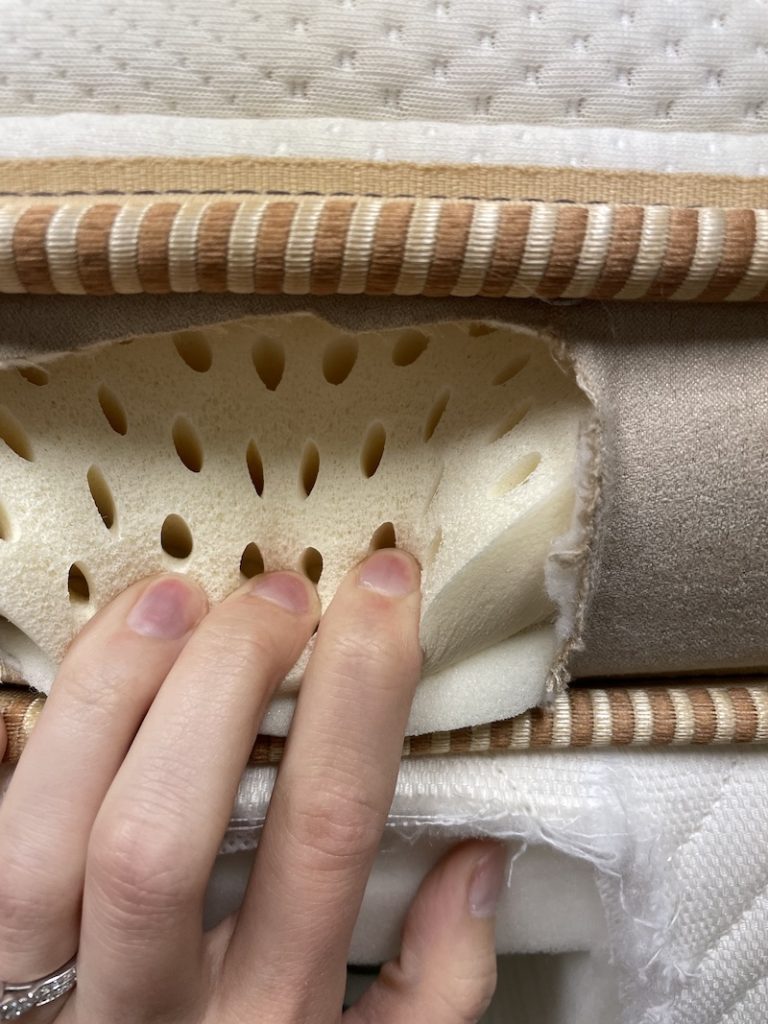
Innerspring
Innerspring mattresses are the most commonly used among people. As you probably already know, it can take a while to break in a new bed at first, but once you’ve molded it to your sleeping position, it can become even more comfortable with time.
Innerspring mattresses tend to feel the firmest of all the bed types. are often less costly. They come in various prices and levels of firmness, which depend on the quality. In the end, there is an innerspring mattress for every budget.
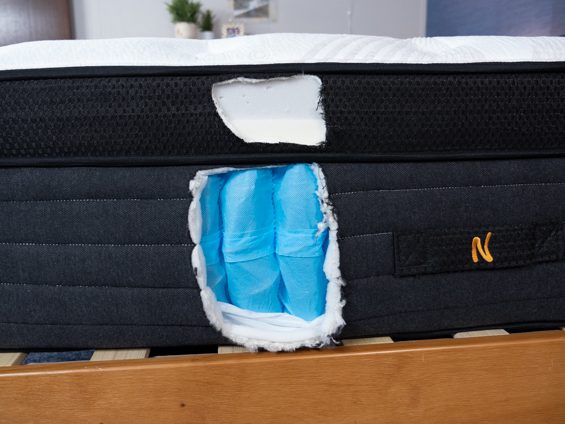
Hybrid
Hybrid mattresses are highly popular because they combine coils with multiple foam layers. They’re different from innerspring beds because they usually have more than one comfort layer. The comfort layers can be made from memory foam, poly foam, latex, or any other type of foam that allows cushioning and contouring for pressure relief. Below that, you’ll usually find coils that offer support and bounce.
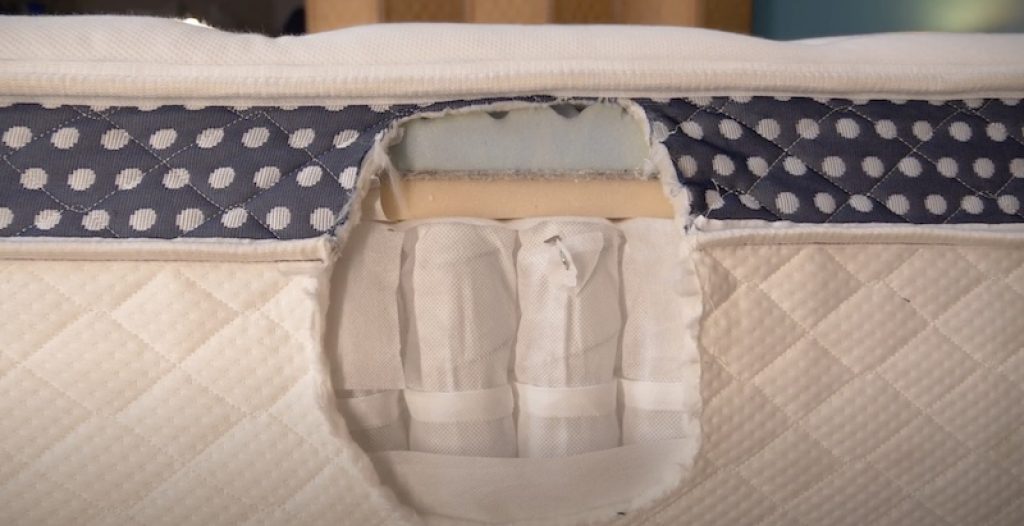
However, hybrids can be pricey, depending on the materials used. In addition, they’re great for teens who run hot at night because the coils allow plenty of airflow to keep the foams cool.
Sleeping Position
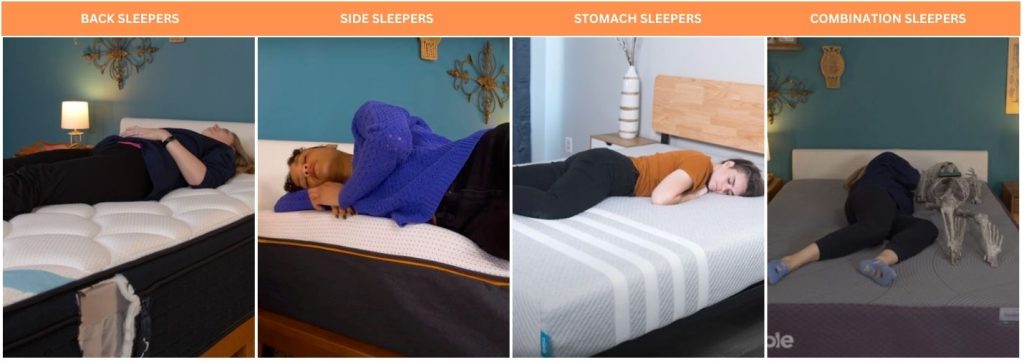
From early on in life, we have a preference for which sleeping position works best for us. Therefore, if teenagers have a preference for a certain position, they should get a bed that’s good for that posture.
- Side sleepers – The side-lying position, also known as the fetal position, is common among teens. A bed needs to be supportive yet comfortable for this position. Too soft, and you may find yourself rolling onto your front. Too firm, and pressure points abound. The arm tends to get in the way when sleeping sideways, so a soft bed will ideally mold more to your shoulder/arm area. On the other hand, some side sleepers may prefer a medium firmness to ensure they’re still supported. Ultimately, it is a personal preference, and your teen’s needs should be considered to make a final decision.
Read More: Best Side Sleepers Mattresses
- Stomach sleepers – Teens who prefer to sleep on their stomachs, also known as prone position, require a reasonable firmness to ensure they don’t wake up due to discomfort or feeling out of alignment. A firmer bed would be a reasonable option for a growing body. More specifically, firmer beds often provide enough lifting in the midsection to keep the spine from curving too much, which could otherwise cause lower back pain. Some teens may also find it difficult to keep their heads turned to the side when a bed is too soft.
Find Out More: Stomach Sleepers Bed Reviews
- Back sleepers – Teens who prefer to sleep on their backs, also known as the supine position, usually benefit the most from medium to medium-firm beds. These beds provide a balance of pressure relief and support. It all comes down to how much back support the mattress provides to bring a good night’s rest.
Check our recommended mattresses for back sleepers if your teen prefers to sleep in this position.
- Combination sleepers – Combination sleepers change positions throughout the night so they typically gravitate toward beds that feel comfortable in different positions and make it easy for them to reposition. To allow for ease of movement, these teens may want a bed with good bounce and responsiveness, which means that the mattress responds quickly when weight is applied. These features are often found in latex, innerspring, and some hybrid beds. Also, beds with a medium firmness can accommodate multiple sleep positions better than something extremely soft or firm.
Firmness
Myself and other Sleep Advisor testers rate mattress firmness on a scale of 1-10, with 10 being the hardest. Since firmness is subjective based on your body type, we also like to include feedback from testers in other weight groups in our mattress reviews.
Based on our scale, anything given a 4 or 4.5 is considered soft. Medium and medium-firm beds range from 5 to 6.5, and anything 7 or higher is considered a firmer mattress. The majority of mattresses fall in the medium range, but some brands offer mattresses in multiple firmness options, which can be great for customization.
If you’re unsure what firmness level your teen would prefer, a universally appealing mid-level firmness may be your best choice.
Cooling / Temperature Regulation
Hormonal changes during puberty can cause teenagers to develop night sweats because the sweat glands are more active.1 With this in mind, a mattress that performs well at temperature regulation could help teens get a good night’s sleep. Certain mattress materials are often better at this than others.
The open structure of the coils in innerspring and hybrid mattresses promotes airflow, which often helps regulate body temperature. Latex is naturally temperature-neutral, making it useful for hot sleepers. Although memory foam is known for retaining heat, many manufacturers have started using cooling gels and other technology to improve these mattresses’ temperature regulation.
Price
Mattresses can be a major expense, and you may not be keen on spending a ton of money on a luxury bed for your teen, especially if they’re not going to use it after high school. The bed’s size and the type of materials can also affect the price, but you can find quality mattresses at all price points.
Before you buy, consider your teen’s plans for the mattress. Will they use it for a longer time? In this case, it might be a better investment to get a larger, more high-end mattress they can use for many years to come. Another tip is to try to purchase the mattress during a major sales event or holiday since many top brands offer fantastic discounts during these times.
Beds for Teenagers FAQs
What type of mattress is best for teens?
Deciding on the best bed for a teenager depends on multiple factors, including their body type, preferred sleep position, and the space available in their room. However, there are some specific features to look for that could help your teen sleep more comfortably.
Given that most people experience significant growth during their teen years, you may want to consider a bed size that will allow them to stretch out.2 Additionally, teenagers can be more susceptible to sweating due to puberty.1 Beds with cooling properties can help with temperature regulation.
What bed should a 14-year-old have?
Considering that 14-year-olds come in all shapes and sizes, no one bed would work best for all of them. However, since they can experience growth spurts during this time, it’s helpful to get a larger bed that can accommodate their growing body.2
Factors such as body type, height, and available space should also be considered when purchasing a bed for a 14-year-old. Additionally, teenagers have more active sweat glands, so getting them a good temperature-regulating bed could be helpful.1 I would recommend moisture-wicking, breathable sheets as well.
What size mattress should a 6-foot-tall teenager have?
Typically, Twin and Full-size beds are around 75 inches long, and Twin XL, Queen, and King mattresses are 80 inches long. Therefore, all standard-sized mattresses are long enough for a 6-foot-tall teenager. However, since they may not be done growing and may want extra room to stretch out, one of the longer beds could give them added comfort.
| Mattress | Best For | Price (Queen Size) | Review |
| DreamCloud | Editor’s Pick | $1,332 | DreamCloud Mattress Review |
| Nectar | Memory Foam | $1,099 | Nectar Mattress Review |
| Helix Midnight | Side Sleepers | $1,199 | Helix Midnight Mattress Review |
| Bear Original | Athletic Teens | $999 | Bear Mattress Review |
| Saatva Classic | Back Sleepers | $1,995 | Saatva Classic Mattress Review |
| Brooklyn Bedding Brooklyn Essential | Hybrid | $932 | Pending |
| Nolah Evolution | Luxury | $2,299 | Nolah Evolution Mattress Review |
| Titan Plus | Plus-Size Teens | $1,249 | Titan Plus Mattress Review |
| Plank Firm | Firm | $1,249 | Plank Firm Mattress Review |
| Birch Natural | Organic | $1,799 | Helix Birch Natural Mattress Review |

Julia Forbes
Lead Product Tester
About Author
Stomach Sleeper
References:
- “Skin, sweat and more: Navigating physical changes during puberty.” Children’s Hospital of Virginia at VCU. 2016.
- “The Growing Child: Teenager (13 to 18 Years)”. Stanford Medicine Children’s Health. Webpage accessed April 9, 2024.
- Soliman, Ashraf., et al. “Advances in pubertal growth and factors influencing it: Can we increase pubertal growth?”. Indian Journal of Endocrinology and Metabolism. 2014.
- Hernandez, Dominic. “Why Are More Children Going Through Puberty At A Younger Age?”. Texas A&M University Health Science Center. 2018.
- “Sleep Problems and Teens”. UCLA Health. Webpage accessed April 9, 2024.
- “Sleep in Middle and High School Students”. Centers for Disease Control and Prevention. Last modified September 2020.
- Ramli, Roslim., et al. “Development of latex foam pillows from deproteinized natural rubber latex”. Journal of Rubber Research. 2021.
